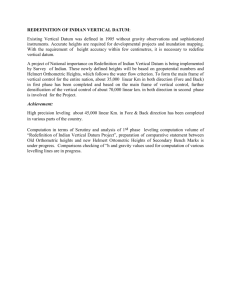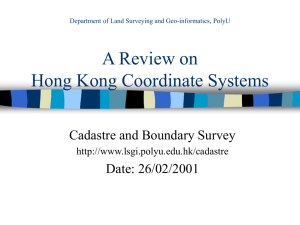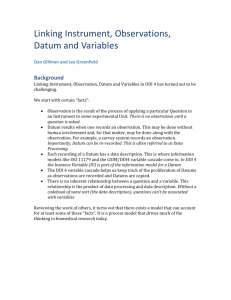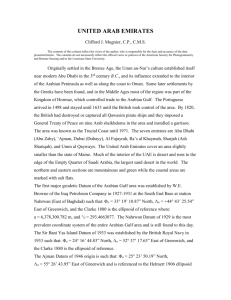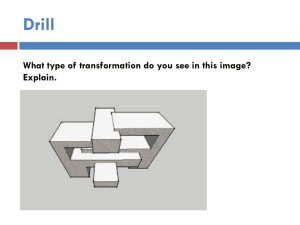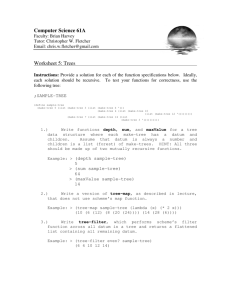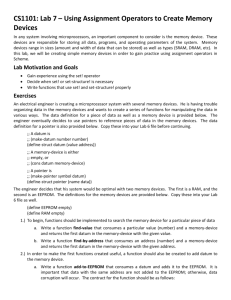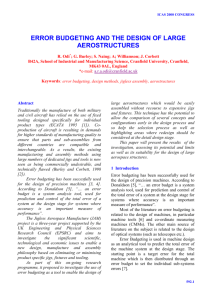0715CD141 - University of Ilorin
advertisement
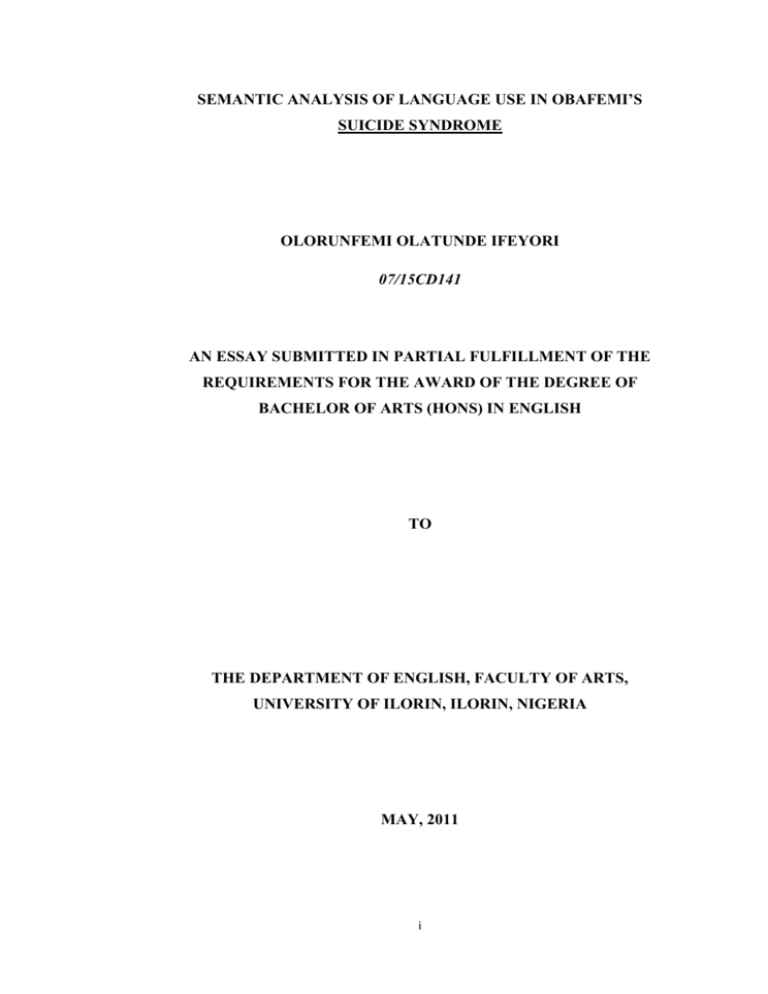
SEMANTIC ANALYSIS OF LANGUAGE USE IN OBAFEMI’S SUICIDE SYNDROME OLORUNFEMI OLATUNDE IFEYORI 07/15CD141 AN ESSAY SUBMITTED IN PARTIAL FULFILLMENT OF THE REQUIREMENTS FOR THE AWARD OF THE DEGREE OF BACHELOR OF ARTS (HONS) IN ENGLISH TO THE DEPARTMENT OF ENGLISH, FACULTY OF ARTS, UNIVERSITY OF ILORIN, ILORIN, NIGERIA MAY, 2011 i CERTIFICATION This project has been read and approved as meeting part of the requirements for the award of Bachelor of Arts Degree in the Department of English of the Faculty of Arts, University of Ilorin. ……………………………… …………………………… DR. T. A. ALABI Date (Supervisor) ……………………………… ……………………………… DR. S. T. BABATUNDE Date (Head of Department) ……………………………… ……………………………… EXTERNAL EXAMINER Date ii DEDICATION To the one and only, The reason for my existence, The one that was, that is, and Is to come, The one that will ever be And never change. ALMIGHTY GOD. iii ACKNOWLEDGEMENTS My greatest gratitude goes to God Almighty who has been my guard. It is only by your grace and love that I am able to pass through the odds in school. You shall forever be conserved in my heart. I also wish to express my unreserved gratitude to my Supervisor, Dr. T. A. Alabi, for the patience and tolerance he had all through the duration of this research work. And for this I am grateful. To all my lecturers who have made me who I am today, I am grateful and I will never forget the effort of my late lecturer, Dr. A. Joseph. You all are the best teachers. To those who gave me life, I cannot in actual sense thank you enough, Mr. & Mrs. N. A. Olorunfemi, you are the best and a true parent. If I am given the chance to choose who my parents shall be in reincarnation if there is, I will only but choice you both. Your love, care and honesty has kept me going. I LOVE YOU To the greatest aunt in the world, Mrs. Alemika, you are one in a million. I will forever be grateful to you and your family. To my siblings, Dekunle, Olorungbemiga and my little cousin Pelumi, you are the best I ever had. I also say a big take you to all my friends that have given me the reason not to be lonely. You all will be forever remembered. iv ABSTRACT The relationship between the meanings of an utterance with what the hearer can infer from such utterance is an interesting field of semantic in linguistics. This research work examines the semantic inputs of language use in Olu Obafemi’s Suicide Syndrome. This research work has employed semantic approach in exploring and identifying the issues of semantic interest in the selected play. The whole play is divided into six movements but the analysis of this work is selected randomly. However, the analysis of this work is based on the theories of meaning, type of meaning and semantic issues which are particular to the data. The result of every analysis indicates that no utterance has conventional static meaning. This study attempts to emphasize the meanings of utterances that can be deduced in the selected play. v TABLE OF CONTENTS Title page i Certification ii Dedication iii Acknowledgements iv Abstract v Table of contents vi CHAPTER ONE General Introduction 1.1 Introduction 1 1.2 The Language of Literature 2 1.3 Drama as a Genre of Literature 4 1.4 Purpose of the study 5 1.5 Scope of the study 5 1.6 Justification of the study 5 1.7 Research Methodology 6 1.8 About the Author and the play 6 CHAPTER TWO Literature Review vi 2.1 Introduction 8 2.2 Semantics: Conceptualization and Scope 8 2.3 Theories of meaning 13 2.3.1 The Referential theory of meaning 13 2.3.2 The Image theory of meaning 14 2.3.3 The Ideational theory of meaning 14 2.3.4 The Behavioural theory of meaning 15 2.3.5 The Contextual theory of meaning 15 2.4 2.5 Geoffrey Leech Seven Type of Meaning 16 2.4.1 Denotative meaning 16 2.4.2 Connotative meaning 17 2.4.3 Affective meaning 17 2.4.4 Reflective meaning 18 2.4.5 Thematic meaning 18 2.4.6 Stylistic meaning 19 2.4.7 Collocative meaning 19 Semantic Issues 20 2.5.1 Homonymy 21 2.5.2 Polysemy 21 2.5.3 Synonymy 22 2.5.4 Antonyms 22 vii 2.5.5 Hyponymy 23 2.5.6 Meronymy 24 2.5.7 Ambiguity 24 2.5.8 Contradiction 24 2.5.9 Tautology 25 CHAPTER THREE 3.0 Introduction 26 3.1 Analysis 26 3.1.1 Datum One 26 3.1.2 Datum Two 27 3.1.3 Datum Three 29 3.1.4 Datum Four 30 3.1.5 Datum Five 31 3.1.6 Datum Six 32 3.1.7 Datum Seven 33 3.1.8 Datum Eight 34 3.1.9 Datum Nine 35 3.1.10 Datum Ten 36 3.1.11 Datum Eleven 37 3.1.12 Datum Twelve 38 3.1.13 Datum Thirteen 39 viii CHAPTER FOUR FINDINGS, SUMMARY, CONCLUSION 4.1 Introduction 41 4.2 Findings 41 4.3 Summary 42 4.4 Conclusion 43 BIBLIOGRAPHY ix
